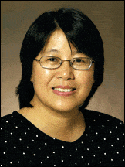Development of a Model for Subsurface Drainage and Subirrigation Water Management Decisions

Kelsey Kolars is an M.S. graduate student in the Agricultural and Biosystems Engineering (ABEN) program at North Dakota State University (NDSU). She holds a Bachelors of Science degree in Mathematics from NDSU. Kelsey is researching the relationship of water tables to crop water consumption by measuring water table levels, soil moisture, irrigation and drainage variables, and weather data. She will incorporate her findings into a new application for subsurface drainage and subirrigation water management.
Email: Kelsey.kolars@my.ndsu.edu
Fellow: Kelsey Kolarsis
Advisor: Xinhua Jia, Ph. D., Assistant Professor, Department of Agricultural and Biosystems Engineering, North Dakota State University.
Degree Progress: M.S. in Agricultural and Biosystems Engineering expected graduation December 2014.
Development of a Model for Subsurface Drainage and Subirrigation Water Management Decisions
In the Midwest, shallow water tables caused by excess precipitation and poor drainage conditions have the potential to increase soil salinity and water logging, and make field trafficability difficult (Guitjens et al., 1997; Skaggs et al., 2010). Lately, the negative impacts of shallow water tables have been seen in the Red River Valley (RRV), which is in large part due to a wet weather cycle since 1993 (Jia et al., 2012). This wet weather cycle has encouraged the installation of subsurface drainage systems (SSD), which help to remove excess water from the soil profile and make trafficability with heavy machinery easier during planting and harvest.
However, these SSD systems have been shown to have a negative impact on water quality by increasing the amount of nitrates and soluble salts in the outflow compared to surface runoff alone (Jia et al., 2012; Skaggs et al., 2010). Thus, an emphasis has been put on controlled drainage (CD) and subirrigation (SI) systems for their ability to not only reduce outflow, by keeping water in the field, but also allow for subirrigation when needed for watering the crops. Even though a CD + SI system has many benefits its success relies heavily on proper management. One potential management option involves the inclusion of SSD, CD, and SI in the Checkbook Method for Irrigation Scheduling.
The Checkbook Method for Irrigation Scheduling is a popular and relatively simple method developed at NDSU and used in the upper Midwest to help with irrigation management decisions (Steele et al. 2010). However, the Checkbook Method is meant for use with an above ground sprinkler irrigation system and does not consider drainage outflow through a SSD system. Thus, the development of irrigation efficiency for a SI or CD + SI system would be helpful when it comes to determining the time and amount of irrigation water needed to reach field capacity. The introduction of SI and SSD in the Checkbook Method would allow the landowner to better manage the soil moisture deficit so that the field remains at optimal moisture conditions. In the end, the results of this study will allow a better understanding on the effects of a shallow water table on crop water consumption and, as a result, assist in the development of better management plans using the modified Checkbook method for a CD + SI system. Benefits of a better management plan for a CD + SI system consist of increased yields, improved water quality, and reduced pumping costs.
Project Objectives:
The research project will focus on subsurface drainage and subirrigation water management by modifying the Checkbook irrigation method. The specific objectives of the study are to:
- Determine the relationships between shallow water tables and crop water consumption.
- Develop net irrigation amount using field measured water table, soil moisture, irrigation/drainage, and weather data.
- Incorporate SI and SSD into the modified Checkbook method to develop a best water management practice for SSD and SI systems.
Progress:
A CD and CD + SI system was installed in the spring of 2012 and both systems were used over the 2012 growing season. In the CD and CD + SI fields, 12 piezometers were installed in the fall of 2011 and water level loggers have been placed in each well during the 2012 growing season. In the CD + SI field, an Eddy Covariance and wireless weather station have been set up in order to collect soil moisture, evapotranspiration, wind speed, soil temperature, relative humidity, air temperature, and rain/snowfall data. In the CD field soil moisture sensors have been installed at six different depths to record soil moisture changes with respect to different water management practices and varying weather conditions. The collection and processing of soil moisture, evapotranspiration, drainage and irrigation data is currently in progress for the 2012 growing season. Regular updates on field activities/progress can be found at aben-saregrant-ndsu.blogspot.com
Significance:
The use/installation of SSD, CD, and SI systems in the RRV has dramatically increased over the last decade. With this increase also comes an increased need for a better understanding of how to optimally manage these systems such that an increase in yield is seen along with a decrease in nitrate loadings and soluble salts to surrounding surface waters. By incorporating net irrigation via a SI system and drainage via a SSD system in the Checkbook method the landowner is given a simple, familiar, and effective way to manage their system.
Conference/Seminar Presentations:
Kolars, K.A., X. Jia, D.D. Steele, T.F. Scherer, and T.M. DeSutter. 2013. Using eddy covariance, soil water balance, and photosynthetically active radiation methods for corn evapotranspiration measurements in the Red River Valley. ASABE Paper No. 131591426. Kansas City, Misso.: ASABE.

Xinhua Jia, P.E., Professor
Morrill Hall Room 204
Department of Agricultural and Biosystems Engineering
North Dakota State University
NDSU Dept. 7620PO Box 6050
Fargo ND 58108-6050
Phone: (701) 231-6453
E-mail: xinhua.jia@ndsu.edu


